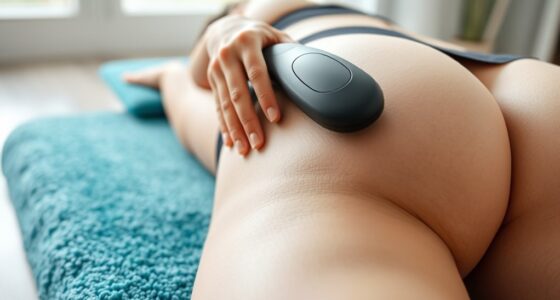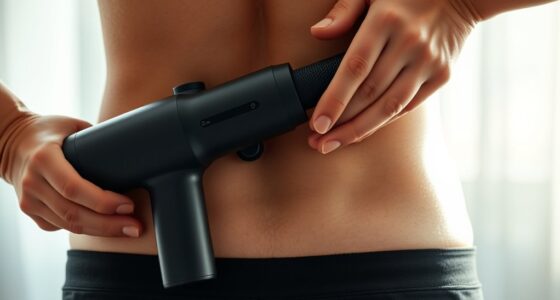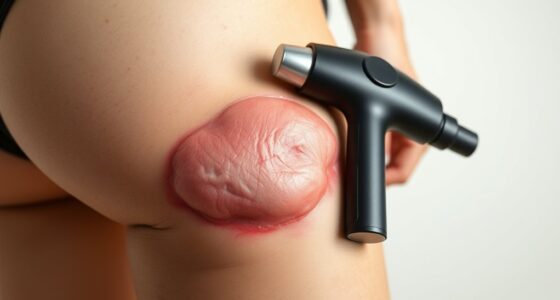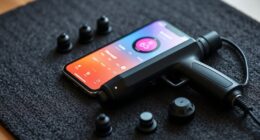To use a massage gun on your forearms after typing, start with low intensity to avoid discomfort. Gently place the device head on your forearm muscles, avoiding bones and joints, and slowly move along the muscle length with overlapping strokes. Focus on areas that feel tight, especially around your wrists. Keep your movements controlled and avoid pressing too hard. For more detailed tips on maximized relief, keep going to find out more.
Key Takeaways
- Start with low intensity and gently rest the massage gun head on the forearm muscles, avoiding bones and joints.
- Use slow, overlapping strokes along the length of the forearm muscles, focusing on areas of tension.
- Target the muscle belly with circular or longitudinal motions to loosen tight muscles and improve blood flow.
- Incorporate wrist stretches before and after massage to enhance flexibility and reduce strain.
- Limit session duration and listen to your body’s signals to prevent over-massaging or discomfort.

Using a massage gun on your forearms can effectively relieve muscle tension, improve circulation, and reduce soreness after workouts or long periods of activity. When targeting this area, it’s essential to prepare your muscles properly by incorporating ergonomic equipment and wrist stretching exercises. Ergonomic equipment, like supportive keyboards and mouse pads, helps minimize strain during prolonged typing or computer work. These tools reduce the overall stress on your forearms and wrists, making the massage process more effective and reducing the risk of injury.
Before using the massage gun, spend a few minutes doing wrist stretches. Gently extend your arm and use your opposite hand to pull your fingers back toward your forearm. Hold this stretch for 15-20 seconds, feeling the tension release in your wrist and forearm muscles. Repeat this a couple of times to loosen up the muscles and improve flexibility. Warming up your forearms with these stretches prepares your muscles for more targeted relief with the massage gun and can prevent overstretching or discomfort during the process.
Warm up your forearms with wrist stretches to enhance flexibility and prevent discomfort during massage sessions.
When applying the massage gun, start with a low intensity setting to avoid overwhelming sensitive tissues. Rest the device’s head gently against your forearm, avoiding direct contact with bones or joints. Move the gun in slow, overlapping strokes along the length of your forearm muscles, focusing on areas that feel tight or sore. You want to target the muscle belly rather than bones or tendons to maximize effectiveness. Keep the movements smooth and controlled; don’t press too hard, as the massage gun’s percussive action is designed to penetrate without excessive force.
Pay special attention to the areas around your wrist, as they often bear the brunt of repetitive tasks like typing. Using ergonomic equipment helps reduce strain here, but a massage gun can deepen relief. Use the device to gently massage around the wrist joint, moving in circular or longitudinal motions. This can help loosen tight muscles and improve blood flow, accelerating recovery. Remember, consistent use after long typing sessions can prevent buildup of tension and make your wrists more resilient over time.
Incorporating wrist stretching alongside massage gun sessions creates a holistic approach to forearm health. Regular stretching increases flexibility, while massage therapy alleviates existing tension. Both strategies work together to prevent injuries, reduce soreness, and enhance overall comfort during repetitive activities. When combined with ergonomic equipment, you’ll notice a significant difference in how your forearms feel after extended periods of typing or manual work. Additionally, massage guns utilize percussive therapy to target deep muscle layers more effectively than manual methods. Keep your sessions moderate in duration and intensity, and always listen to your body to avoid overstimulation or discomfort.
Frequently Asked Questions
Can I Use a Massage Gun on Other Parts of My Arms?
Yes, you can use a massage gun on other parts of your arms. It’s effective for targeting arm muscles like biceps and triceps, helping to relieve tension and improve circulation. Just follow proper massage techniques, applying gentle pressure and moving the device slowly. Avoid sensitive areas like joints or bony prominences. Always listen to your body, and if you feel discomfort, stop and consult a professional if needed.
How Often Should I Use a Massage Gun for Forearm Relief?
You should use a massage gun on your forearms 2-3 times a day, but always listen to your body. Keep your massage frequency moderate to avoid overdoing it, which could lead to injury considerations like bruising or soreness. Start with short sessions of about 1-2 minutes per area, and increase gradually. If you experience pain or discomfort, reduce the frequency or consult a healthcare professional.
Is It Safe to Use a Massage Gun if I Have Arm Injuries?
Before using a massage gun, you should be cautious about injuries. If you have arm injuries, consult your healthcare provider because massage contraindications vary. Using a massage gun during injury recovery could worsen damage or delay healing. Proceed prudently; prioritize professional advice to prevent problems. Remember, safe solutions safeguard your health, so avoid aggressive actions and get expert guidance to ensure proper, pain-free progress.
What Pressure Settings Are Best for Forearm Muscle Relief?
When using a massage gun on your forearms, start with low pressure intensity to avoid discomfort. Use gentle, controlled movements and gradually increase pressure if tolerated. Keep the massage duration around 1-2 minutes per area, ensuring you don’t overdo it. This approach helps relieve muscle tension effectively after typing, reducing strain without causing soreness or irritation. Always listen to your body and adjust settings accordingly for ideal relief.
Can a Massage Gun Help Improve Circulation in the Forearms?
Imagine you’re in the age of chariots and scrolls—a time of change. A massage gun can indeed help improve circulation in your forearms by stimulating blood flow, which boosts circulation benefits and supports muscle recovery. Regular use eases tension and enhances nutrient delivery to muscles, helping you recover faster after typing or other activities. So, yes, a massage gun is a handy tool to keep your forearms healthy and energized.
Conclusion
So, next time your forearms scream after hours of typing, remember a massage gun might just be your best friend. Who would’ve thought that a device designed for relaxation could double as your keyboard’s secret weapon? Irony at its finest—sometimes, the best relief comes from a gadget you barely knew existed. So go ahead, give it a try, and maybe, just maybe, you’ll find yourself loving those long workdays a little more.









